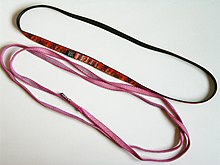Tape sling
The sling is an aid for fall protection and height rescue as well as an additional piece of equipment for the personal equipment of fire brigade members . It is a ring-shaped, linked band made of particularly resilient synthetic fibers that can have a load-bearing capacity of several tons.
material
Belt slings made of polyamide or high-modulus polyethylene are used for climbing . Also Polyester is increasingly used.
The band material can be made from a flat woven belt or also from a round woven tubular band. Belt loops sewn from tubular tape are narrower with the same breaking load.
When climbing
The tape sling is used for self- belaying and for stand construction. As an intermediate safeguard when climbing , it is usually placed as a head or serrated loop over or around protruding rock heads or slabs or guided through hourglasses . Belt slings are also used as an extension between the hook and the carabiner. When lead climbing finds as quickdraw frequent use.
Nowadays, sewn slings are mainly used for climbing. These must meet the EN 566 standard and have a minimum breaking load of 22 kN. The actual nominal breaking load is to be marked on the sling, this is usually done on a label attached to the seam. Typical lengths are 30, 60, 120 and 240 cm.
Tape material for mountain sports is also available as unsewn yard goods, but is used less and less. It must meet the EN 565 standard (tape). This writes u. a. propose to indicate the tear resistance by means of continuous contrasting colored lines woven in lengthways in the middle. Each line means a breaking load of 5 kN, whereby a minimum breaking load of 10 kN (two lines) is required.
In the past, mountaineers used the ribbon loop knot to form a loop from tape material from the roll . This method, which has been practiced for a long time, is now urgently advised against. The loop knot can easily open itself if it gets caught on a small point and can then be completely loosened even with very little stress. For this reason it is now also referred to as the “death knot” in alpine safety literature.
The figure of eight is safer than the ribbon loop knot . Although this knot does not hold with ribbons made of smoother Dyneema, these are not sold by the meter due to their poor knotability.
Belt slings, especially their seams, are susceptible to abrasion, crushing, edge and fall loads as well as heat and chemicals.
At the fire department
The sling can be used for a variety of tasks in the fire service. Carrying a sling with you when firing in an indoor attack is not mandatory for fire departments in Germany, but it is recommended and practiced in many places.
A group can use the noose to connect to each other in order to maintain contact in smoky objects. The search of rooms can also be improved with certain search techniques with a tape sling. It can also be used to open a door by pulling the doorknob out of cover.

If, in the event of an immediate rescue, due to time pressure, lack of material or impending danger, it is not possible to rescue with a stretcher or rescue sheet, an accident victim can also be rescued with the sling. To do this, the noose is pulled apart and placed under the arms around the body of the accident victim. The noose is crossed behind the head to stabilize the head. The length of the loop should be at least 1.50 m. If the person involved in the accident is wearing a breathing apparatus , the sling can be passed through the breathing apparatus and the person pulled.
Since slings are not required by the fire brigade, they do not have to meet any standard. Therefore, sometimes material is used that is not approved as climbing equipment.
Service life
Belt slings age due to mechanical stress, dirt and UV radiation , so that their breaking load decreases over time. Even when unused, the synthetic fibers lose their tear resistance over the years. A weak loop may be used for safety-related applications such as B. occurs when climbing, are no longer used.
The degree of aging depends on the frequency and type of use, as well as the material. Dyneema tape slings age faster than polyamide, which means that they are in the critical strength range after just three to five years. Polyamide slings still have safety reserves after six to ten years. There is a strong correlation between optical condition and strength, so that one can decide on the basis of the visual impression when a sling should be discarded. With age, polyamide slings become very furry or frayed. With Dyneema, the color is a good indicator: the initially white fibers turn gray over time.
Web links
Individual evidence
- ↑ Peter Plattner: dialog: Polyester . In: mountaineering . No. 100 , 2017, p. 14 ( PDF [accessed March 15, 2019]).
- ^ Pit Schubert: Safety and risk in rock and ice . 6th edition. tape 1 . Rother, Munich 2001, p. 170 f .
- ↑ Walter Siebert: Let's wait a few more deaths . In: mountaineering . No. 2 . Innsbruck 2007, p. 38–45 ( PDF [accessed July 17, 2015]).
- ↑ a b Look instead of trust . Service life of tape slings. In: DAV Panorama . No. 4 , 2015, p. 58–61 ( PDF [accessed July 17, 2015]).



